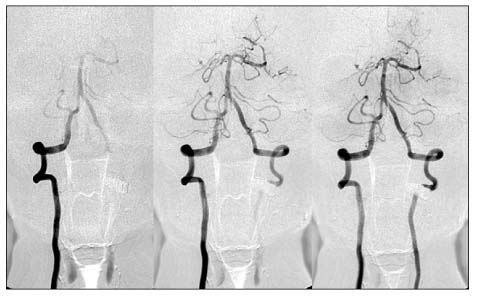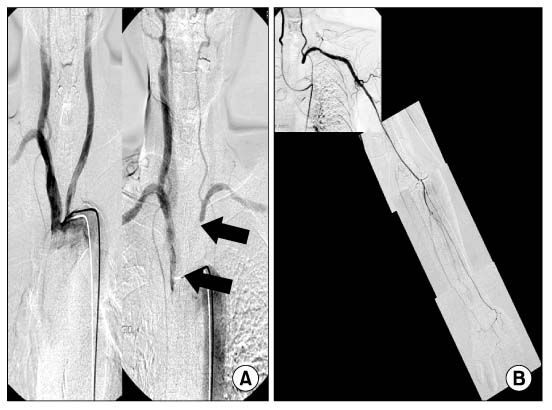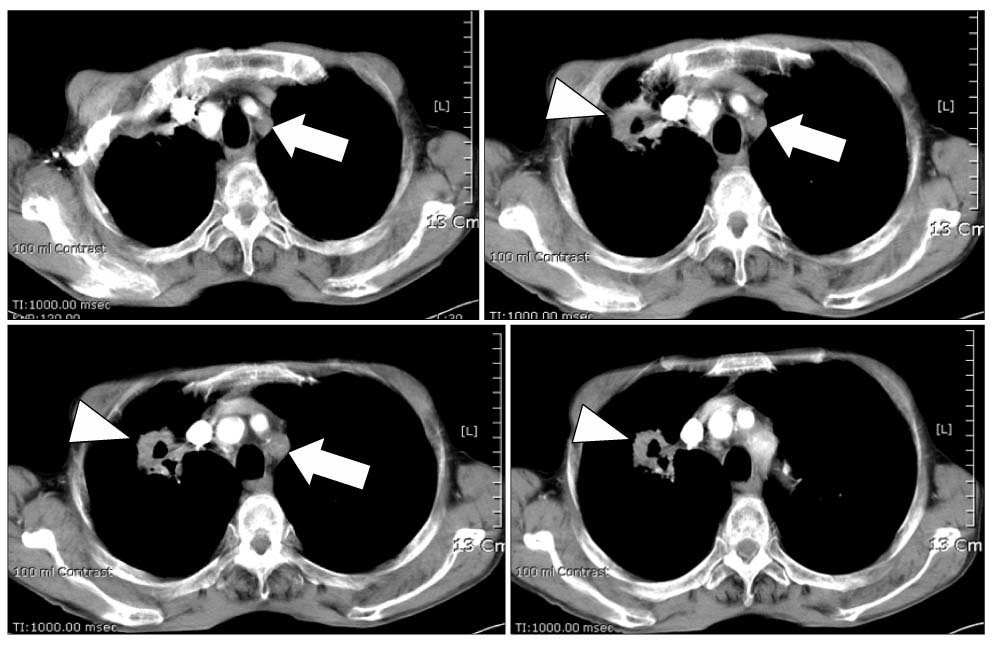J Korean Surg Soc.
2009 Mar;76(3):203-206. 10.4174/jkss.2009.76.3.203.
Subclavian Steal Syndrome
- Affiliations
-
- 1Department of Surgery, College of Medicine, Hallym University, Chuncheon, Korea. jhunlee69@hallym.or.kr
- KMID: 2096545
- DOI: http://doi.org/10.4174/jkss.2009.76.3.203
Abstract
- The definition of subclavian steal is the reversal of vertebral blood flow resulting from the stenosis or occlusion of one of the subclavian arteries or the innominate artery. It is a rare disease resulting in a variety of ischemic neurologic symptoms such as vertigo, dizziness, diplopia, dysarthria, ataxia and nystagmus. Some patients show ischemic symptoms and digital necrosis of the involved arm. Among treatment options, Subclavian to carotid transposition is the most preferred method. We report a patient with subclavian steal syndrome who had 5th finger necrosis of the left hand without neurologic symptoms. It was successfully treated with a carotid-subclavian bypass with a 6 mm ePTFE graft.
MeSH Terms
Figure
Reference
-
1. Fisher CM. A new vascular syndrome? 'the subclavian steal'. N Engl J Med. 1961. 265:912–913.2. Zimmerman NB. Occlusive vascular disorders of the upper extremity. Hand Clin. 1993. 9:139–150.3. Webster MW, Downs L, Yonas H, Makaroun MS, Steed DL. The effect of arm exercise on regional cerebral blood flow in the subclavian steal syndrome. Am J Surg. 1994. 168:91–93.4. Welling RE, Cranley JJ, Krause RJ, Hafner CD. Obliterative arterial disease of the upper extremity. Arch Surg. 1981. 116:1593–1596.5. Pollard H, Rigby S, Moritz G, Lau C. Subclavian steal syndrome: a review. Australas Chiropr Osteopathy. 1998. 7:20–28.6. Schardey HM, Meyer G, Rau HG, Gradl G, Jauch KW, Lauterjung L. Subclavian carotid transposition: an analysis of a clinical series and a review of the literature. Eur J Vasc Endovasc Surg. 1996. 12:431–436.7. Mingoli A, Feldhaus RJ, Farina C, Schultz RD, Cavallaro A. Comparative results of carotid-subclavian bypass and axillo-axillary bypass in patients with symptomatic subclavian disease. Eur J Vasc Surg. 1992. 6:26–30.8. Koh YB, Suh KH, Lee YK. Successful correction of subclavian steal syndrome by proximal axillo-axillary bypass graft with autogenous Saphenous vein. J Korean Surg Soc. 1980. 22:67–73.9. Do BS, Suh BY, Kwun KB. Axillo-axillary artery bypass graft for the treatment of subclavian steal syndrome: experience of 3 cases. J Korean Vasc Surg Soc. 1991. 7:36–41.10. Erbstein RA, Wholey MH, Smoot S. Subclavian artery steal syndrome: treatment by percutaneous transluminal angioplasty. AJR Am J Roentgenol. 1988. 151:291–294.
- Full Text Links
- Actions
-
Cited
- CITED
-
- Close
- Share
- Similar articles
-
- Axillo-axillary artery bypass graft for the treatment of subclavian steal syndrome experience of 3 cases
- A Case of Turner Syndrome with Coarctation and Subclavian Steal Syndrome by the Left Subclavian Artery from the Descending Aorta Below the Coarcted Segment
- Recurrence of Coronary-Subclavian Steal Syndrome After Successful Angioplasty of Malfunctioning Arteriovenous Fistula
- A Case of Right Subclavian Steal Syndrome
- Color Doppler Imaging of Subclavian Steal Phenomenon




